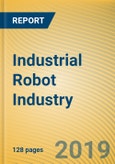In 2018, a total of 156,400 industrial robots were sold in China, soaring by 14.97% on an annualized basis, making China be the largest consumer of industrial robots in the world for six consecutive years.
The burgeoning development of industrial robots is facilitated by the two below. First, the applied markets-- automobile, high-end equipment manufacturing, and electronics & appliances -- have developed radically; second, the innovation capability of Chinese industrial robots has been improved progressively and localization of core components has risen.
Concerning robot types, articulated handling robot still prevailed in 2018, and its strong sales growth serves as a stimulus for the quality improvement of Chinese robots. By application, handling and welding robots are still in a dominant position, and the sales volume of robots for processing (laser cutting, mechanical cutting, deburring, polishing, etc.) also increased a lot.
Speed reducer, controller and servo system are the core components of an industrial robot, sharing more than 70% of the total cost. In recent years, China has made remarkable progress in the localization of controllers and servo systems but has tried in vain in mass production of speed reducers due to the high technical barriers. The Chinese speed reducer market has been monopolized by Japanese companies (Nabtesco's RV speed reducers occupy about 60%, and Harmonica's harmonic speed reducers make up about 15%), while Chinese players rely on imports heavily. In the future, only breakthroughs have been made in speed reducer can bring a rosy outlook for Chinese robots.
At present, Switzerland ABB, Germany KUKA, Japan FANUC, and Yaskawa occupy about 60% of the Chinese industrial robot market, and they are scrambling for more, particularly quicker expansion in 2018.
In the meantime, Chinese industrial robot producers performed brilliantly as well in 2018. ESTUN earned the revenue of RMB735 million from industrial robots and intelligent manufacturing systems in 2018, an upsurge of 50.28% over last year, and with an anticipated growth rate of 20% in 2019. Brotherobot outperformed its goal by selling 15,788 manipulators and 5,137 robots (compared with only 351 units in 2017) and ranked first in China by the sales volume of robots made in China. EFORT officially rolled out a new generation of ER3B-C10 robot, and on February 2019 it started its next-generation intelligent industrial robot R&D and industrialization project.
Global and China Industrial Robot Industry Report, 2019-2025 by ResearchInChina focuses on the following:
- Market size, market structure, key enterprises, etc. of global industrial robots;
- Development history, market size, supply and demand, market structure, investment, and development prospect, etc. of Chinese industrial robots;
- Market size, business structure, future trends, etc. of Chinese key industrial robot components (speed reducer, controller and servo system);
- 10 key global companies including ABB, KUKA, FANUC, and Yaskawa (industrial robot business, layout in China, future planning, etc.);
- 23 key Chinese companies including SIASUN Robot & Automation, Shanghai STEP Electric, ESTUN, EFORT and Brotherobot (operation, industrial robot business, R&D, future strategy, etc.)
This product will be delivered within 3-5 business days.
Table of Contents
Companies Mentioned
- ABB
- Brotherobot
- Changzhou Mingseal Robotic Technology
- Comau
- EFORT
- ESTUN
- FANUC
- GSK CNC Equipment
- Harbin BOSHI Automation
- Honyen Automation Equipment
- HS Robotics
- HUAHENG Welding
- Hyundai Heavy Industries
- Inovance Technology
- Kawasaki Heavy Industries
- KUKA
- MESNAC
- NACHI
- OTC
- Peitian Robot
- Qianjiang Robot
- QKM
- ROKAE
- Shanghai STEP Electric
- Shanghai Triowin Automation Machinery
- Shenzhen Jasic Technology
- SIASUN Robot & Automation Co, Ltd
- STSrobotics
- Stäubli
- Suzhou Boshi Robotics Technology
- YASKAWA
Methodology

LOADING...








